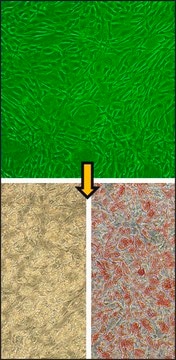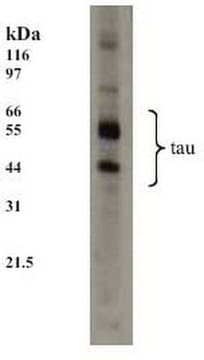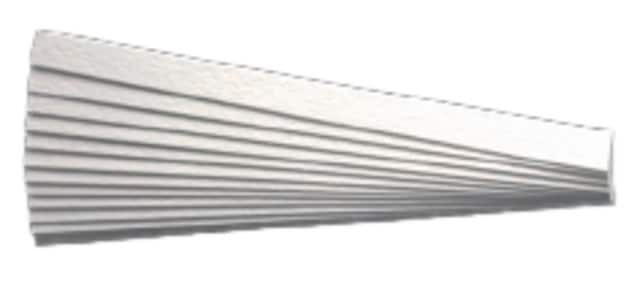S802S-05A
Human Preadipocytes: HPAd: Pre-Screened for Adipogenesis Signaling, adult subcutaneous
About This Item
Polecane produkty
pochodzenie biologiczne
human adipose tissue
Poziom jakości
opakowanie
pkg of 500,000 cells
producent / nazwa handlowa
Cell Applications, Inc
tryb wzrostu
Adherent
kariotyp
2n = 46
morfologia
adipocyte
metody
cell culture | mammalian: suitable
powiązane choroby
diabetes; obesity; cardiovascular diseases
Warunki transportu
dry ice
temp. przechowywania
−196°C
Opis ogólny
Most research in adipocyte biology was conducted in mouse 3T3-L1 cell lines. It has been impossible to use human adipocytes because they die within 24 hours after isolation. To facilitate the study of human adipocyte biology, primary Human Preadipocytes (HPAd) have been derived from human subcutaneous adipose tissue at various sites and adipose depot on the heart. These fibroblast-like precursor cells are cryopreserved at the end of primary culture and can be propagated two passages prior to differentiating into Human Adipocytes (HAd). Complete differentiation can be easily achieved through the use of Adipocyte Differentiation Medium. Mature HAd are expected 10 days after induction of differentiation and should remain healthy and responsive for at least 2 weeks after complete differentiation. Adipose mass can be controlled by inhibition of HPAd differentiation and increase of lypolysis. HAd are ideal cellular models for drug discovery research in the area of obesity, diabetes and cardiovascular diseases.
HPAd have been used in multiple studies investigating the cellular basis of diabetes and obesity, as well as mechanisms of action of various drug candidates. For example, it was shown that interaction between infiltrating monocytes and adipocytes affects production of metalloproteinases and osteopontin, a proinflammatory cytokine, which ultimately leads to development of more adipose tissue and insulin resistance (Samuvel, 2010, 2011). It was further demonstrated that adipocyte differentiation requires activation of Akt1 through the mTORC2-BSTA mechanism, leading to downstream suppression of FoxC2 (Yao, 2013).
- Instead of protecting from hyperglycemia-induced ER stress, like it does in other cells, in adipocytes a bioactive, endogenously produced compound taurine was shown to modulate the expression of adipokines under inflammatory conditions by inhibiting the STAT-3 signaling pathway (Kim, 2013a,c), and to inhibit differentiation of preadipocytes into adipocytes (Kim, 2013b). Additionally, FGF21, which leads to reduction of body weight in animal models of obesity, was shown to act by modulating gene expression, phosphorylating Frs2a, Erk1/2, and Mypt1 (Muise, 2013) and by increasing oxidative capacity of adipocytes via AMPK–SIRT1–PGC1a cascade (Chau, 2010). Similarly, atrial natriuretic peptide (ANP) was shown to regulate lipid catabolism and reduce insulin resistance in HPAd by activating AMPK (Souza, 2011).
- HPAd were also used to study adipocytokines in normal pregnancy and pregnancy-induced hypertension (Naruse, 2011), and to investigate the anti-obesity and hypolipidaemic properties of lotus seed extract (You, 2013, 2014). Finally, HPAd (along with Human Dermal Fibroblasts) have been used to demonstrate the role of epigenetic modifications in increasing efficiency of iPS reprogramming (Rim, 2012).
Pochodzenie linii komórkowej
Zastosowanie
Komponenty
Uwaga dotycząca przygotowania
- 2nd passage, >500,000 cells in Preadipocyte Cell Basal Medium that contains 20% FBS and 5% DMSO
- Can be cultured 2 passages before differentiation into Had
Rutyna subkultury
Oświadczenie o zrzeczeniu się odpowiedzialności
Kod klasy składowania
11 - Combustible Solids
Klasa zagrożenia wodnego (WGK)
WGK 3
Temperatura zapłonu (°F)
Not applicable
Temperatura zapłonu (°C)
Not applicable
Certyfikaty analizy (CoA)
Poszukaj Certyfikaty analizy (CoA), wpisując numer partii/serii produktów. Numery serii i partii można znaleźć na etykiecie produktu po słowach „seria” lub „partia”.
Masz już ten produkt?
Dokumenty związane z niedawno zakupionymi produktami zostały zamieszczone w Bibliotece dokumentów.
Klienci oglądali również te produkty
Protokoły
Store the cryovials in a liquid nitrogen storage tank immediately upon arrival.
Przechowywać fiolki krio w zbiorniku z ciekłym azotem natychmiast po ich dostarczeniu.
Nasz zespół naukowców ma doświadczenie we wszystkich obszarach badań, w tym w naukach przyrodniczych, materiałoznawstwie, syntezie chemicznej, chromatografii, analityce i wielu innych dziedzinach.
Skontaktuj się z zespołem ds. pomocy technicznej







